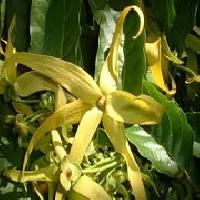
Ylang Ylang
Cananga odorata, commonly called ylang-ylang ee-lang-ee-lang),[1] cananga tree, ilang-ilang, kenanga in Indonesian, fragrant cananga, Macassar-oil plant or perfume tree,[2] is a tropical tree which originates from the Philippines and is valued for its perfume. The essential oil derived from the flowers is used in aromatherapy.Artabotrys odoratissimus, ylang-ylang vine, and Artabotrys hexapetalus, climbing ylang-ylang,[5] are woody, evergreen climbing plants in the same family. A. odoratissimus is also a source of perfume.C. odorata is a fast-growing tree of the custard-apple family Annonaceae. Its growth exceeds 5 m (15 ft) per year[citation needed] and attains an average height of 12 m (40 ft) in an ideal climate. It grows in full or partial sun, and prefers the acidic soils of its native rainforest habitat. The evergreen leaves are smooth and glossy, oval, pointed and with wavy margins, and 13–20 cm (5–8 in) long. The flower is drooping, long-stalked, with six narrow, greenish-yellow (rarely pink) petals, rather like a sea star in appearance, and yields a highly fragrant essential oil.
...more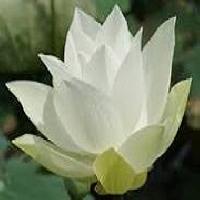
White Lotus
Nymphaea lotus, the tiger lotus, white lotus or Egyptian white water-lily, is a flowering plant of the family Nymphaeaceae. It grows in various parts of East Africa and Southeast Asia. Nymphaea lotus f. thermalis is a variety endemic to the thermal water of the Peţa River in the Bihor County, Transylvania, Romania, in Europe. It is found in ponds, and prefers clear, warm, still and slightly acidic waters. It can be found in association with other aquatic plant species such as Utricularia stellaris. Nymphaea lotus is often used as a freshwater aquarium plant. Sometimes it is grown for its flowers, while other aquarists prefer to trim the lily pads, and just have the underwater foliage.The tiger-like variegations appear under intense illumination. In ancient times the Egyptian lotus was worshipped, especially in Egypt. It was considered a symbol of creation there. In Ancient Greece, it was a symbol of innocenceand modesty. The Egyptian lotus is the national flower of Egypt. It is depicted on many of the seals of the different Provinces in Thailand. It is also an element of the Coptic flag. In some part of Africa the rhizomes and tubers are eaten for the starch they contain either boiled, roasted or ground to a flour after drying. The young fruits are sometimes consumed as a salad. The seeds are turned into a meal.The tubers or the seeds are used as a famine food in India.
...more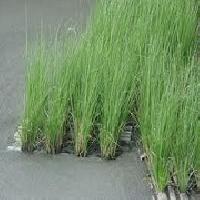
vetiver grass
We are the main supplier of this product.
Type : Fresh
Application : Medicine Use
Cultivation Type : Organic
Maturity : 99%
Color : Green
...more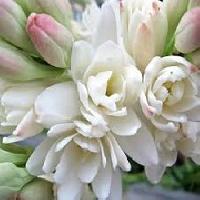
tuberose
Polianthes tuberosa doesn't have any botanical or olfactory relation to roses, despite the name. This small white blossom flowering plant is its own thing, a "white floral" (in the same class as jasmine and orange blossom) with an intensity and creaminess beyond any other: Though the scent can be likened to that of orange blossom and gardenia, tuberose has interesting facets of camphor in the opening (comparable to - but not quite that green - as budding gardenias), of dewy mushroom and earth when in bloom and then of rot and bloody meat when browning. Buttery, rubbery and even metallic facets also emerge if one searches for them. The natural blossoms are so powerful they can fill a room and continue to exude their scent for days after picking. The tuberose (Polianthes tuberosa) is a perennial plant related to the agaves, extracts of which are used as a middle note in perfumery. The common name derives from the Latin tuberosa, meaning swollen or tuberous in reference to its root system. Polianthes means "many flowers" in Greek. In Mexican Spanish the flower is called nardo or vara de San José, which means ‘St. Joseph’s staff’.
...more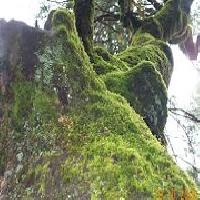
Tree Moss
Tree Moss, the plants of the genus Climacium (order Bryales), which resemble small evergreen trees and are found in damp, shady places throughout the Northern Hemisphere. The most common species are the European tree moss (C. dendroides), which is also found in North America, and the American tree moss (C. americanum). Both are about 5 to 10 centimetres (2 to 4 inches) high, with the branches clustered at the top of the shoot. The reddish-brown capsules (spore cases), borne on the female plant, have lids with long beaks and mature in the fall. The American tree moss has longer, narrower capsules with longer beaks and a leaf different from that of the European tree moss. Both species produce new shoots vegetatively each year from horizontal stems growing on the soil surface.
...more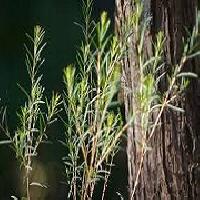
tea tree
Leptospermum scoparium, commonly called manuka, New Zealand teatree,broom teatree or just tea tree, is a species of flowering plant in the myrtle family Myrtaceae, native to New Zealand and southeast Australia.It is a prolific scrub-type tree and is often one of the first species to regenerate on cleared land. It is typically a shrub growing to 2–5 m (7–16 ft) tall, but can grow into a moderately sized tree, up to 15 m (49 ft) or so in height. It is evergreen, with dense branching and small leaves 7–20 mm long and 2–6 mm broad, with a short spine tip. The flowers are white, occasionally pink, 8–15 mm (rarely up to 25 mm) in diameter, with five petals. This species is often confused with the closely related species kanuka – the easiest way to tell the difference between the two species in the field is to feel their foliage – mānuka leaves are prickly, while kānuka leaves are soft. The wood is tough and hard.Evidence suggests that L. scoparium originated in Australia before the onset of the Miocene aridity, and dispersed relatively recently from eastern Australia to New Zealand.
...more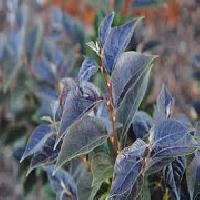
styrax
Styrax is a genus of about 130 species of large shrubs or small trees in the family Styracaceae, mostly native to warm temperate to tropical regions of the Northern Hemisphere, with the majority in eastern and southeastern Asia, but also crossing the equator in South America.Common names include styrax, or the more ambiguous storax, snowbell.Styrax trees grow to 2–14 m tall, and have alternate, deciduous or evergreen simple ovate leaves 1–18 cm long and 2–10 cm broad. The flowers are pendulous, with a white 5-10-lobed corolla, produced 3-30 together on open or dense panicles 5–25 cm long. The fruit is an oblong dry drupe, smooth and lacking ribs or narrow wings, unlike the fruit of the related snowdrop trees (Halesia) and epaulette trees (Pterostyrax).Since Antiquity, styrax resin has been used in perfumes, certain types of incense, and medicines.There is some degree of uncertainty as to exactly what resin old sources refer to. Turkish sweetgum (Liquidambar orientalis) is a quite unrelated tree in the family Altingiaceae that produces a similar resin traded in modern times as storax or as "Levant styrax," like the resins of other sweetgums, and a number of confusing variations thereupon.
...more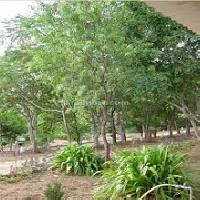
Sandal
Sandalwood is the name of a class of fragrant woods from trees in the genus Santalum. The woods are heavy, yellow, and fine-grained, and unlike many other aromatic woods, they retain their fragrance for decades. Sandalwood oil is extracted from the woods for use. Both the wood and the oil produce a distinctive fragrance that has been highly valued for centuries. Consequently, the slow-growing trees have been overharvested in many areas.Sandalwoods are medium-sized hemiparasitic trees, and part of the same botanical family as European mistletoe. Notable members of this group are Indian sandalwood (Santalum album) and Australian sandalwood (Santalum spicatum); others in the genus also have fragrant wood. These are found in Pakistan, India, Nepal, Bangladesh, Sri Lanka, Australia, Indonesia, Hawaii, and other Pacific Islands.
...more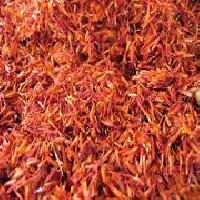
Saffron
Saffron is a spice derived from the flower of Crocus sativus, commonly known as the saffron crocus. Crocus is a genus in the family Iridaceae. Saffron crocus grows to 20–30 cm (8–12 in) and bears up to four flowers, each with three vivid crimson stigmas, which are the distal end of a carpel. Together with the styles, or stalks that connect the stigmas to their host plant, the dried stigmas are used mainly in various cuisines as a seasoning and colouring agent. Saffron, long among the world's most costly spices by weight is native to Greece or Southwest Asia and was first cultivated in Greece. As a genetically monomorphic clone, it was slowly propagated throughout much of Eurasia and was later brought to parts of North Africa, North America, and Oceania. The saffron crocus, unknown in the wild, probably descends from Crocus cartwrightianus, which originated in Crete C. thomasii and C. pallasii are other possible precursors. The saffron crocus is a triploid that is "self-incompatible" and male sterile. It undergoes aberrant meiosis and is hence incapable of independent sexual reproduction—all propagation is by vegetative multiplication via manual "divide-and-set" of a starter clone or by interspecific hybridisation.If C. sativus is a mutant form of C. cartwrightianus, then it may have emerged via plant breeding,which would have selected for elongated stigmas, in late Bronze Age Crete.
...more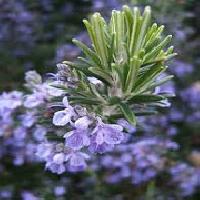
Rosemary
Rosmarinus officinalis, commonly known as rosemary, is a woody, perennial herb with fragrant, evergreen, needle-like leaves and white, pink, purple, or blue flowers, native to the Mediterranean region. It is a member of the mint family Lamiaceae, which includes many other herbs. The name "rosemary" derives from the Latin for "dew" (ros) and "sea" (marinus), or "dew of the sea". The plant is also sometimes called anthos, from the ancient Greek word ?????, meaning "flower".Rosmarinus officinalis is one of 2-4 species in the genus Rosmarinus'.
...more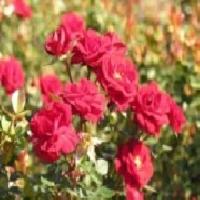
Rose Oil
ROSE The distilled essence of organically grown Rosa damascena flowers in the Himalayan mountains of India is a rare and precious aromatic treat. Currently only a few innovative farmers are engaged in growing in distilling Rosa damascena in several remote areas but the oil that they produce is of a remarkably lovely quality.This precious essential rose oil, like Rosa damascena otto distilled in several other countries like Bulgaria, South Africa and Turkey, is a clear, transparent liquid when temperatures are warmer but as soon as cooler temperatures prevail becomes a solid or semi solid waxy mass due to the presence of steroptenes-floral waxes that come over in the process of distillation.
...more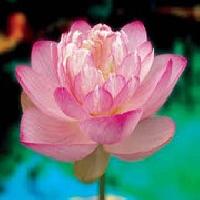
Pink Lotus
Lotus Flower" redirects here. For the Woody Shaw album, see Lotus Flower (Woody Shaw album). For the Radiohead song, see Lotus Flower (song). Nelumbo nucifera known by numerous common names including Indian lotus, sacred lotus, bean of India, or simply lotus, is one of two species of aquatic plant in the family Nelumbonaceae. The Linnaean binomial Nelumbo nucifera (Gaertn.) is the currently recognized name for this species, which has been classified under the former names, Nelumbium speciosum (Willd.) and Nymphaea nelumbo, among others. Names other than Nelumbo nucifera (Gaertn.) are obsolete synonyms and should not be used in current works.
...more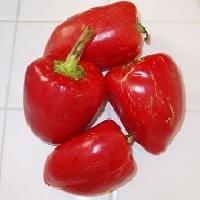
pimento
A pimiento or cherry pepper is a variety of large, red, heart-shaped chili pepper that measures 3 to 4 inches long and 2 to 3 inches wide. The flesh of the pimiento is sweet, succulent, and more aromatic than that of the red bell pepper.Some varieties of the pimiento type are hot, including the Floral Gem and Santa Fe Grande varieties.The seeds can be sown in pots in the house six to eight weeks before setting outside to harden before planting in the soil. Do not plant them where tomatoes, potatoes or eggplant had been planted, as all are members of the nightshade family. This can cause diseases relative to that family.
...more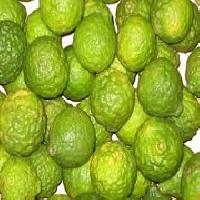
petitgrain
Petitgrain is an essential oil that is extracted from the leaves and green twigs of the bitter orange plant (Citrus aurantium var. amara) via steam distillation.Its main regions of production are Paraguay and France, with the former's product being of higher odour tenacity. Petitgrain oil (fr. little grain) gains its name from the fact that it used to be extracted from the small unripe oranges of the plant. The oil has a greenish woody orange smell that is widely used in perfumery and found in colognes.Though distilled from the same botanical species as neroli and bitter orange, Petitgrain Essential Oil possesses its own characteristically unique aroma. Petitgrain Essential Oil is distilled from the leaves and sometimes the twigs and branches of the tree whereas neroli essential oil is distilled from the blossoms and Orange Essential Oil is typically cold pressed from the rinds of the fruits.
...more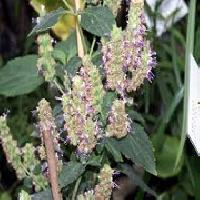
Patchouli
Patchouli (Pogostemon cablin (Blanco) Benth; also patchouly or pachouli) is a species of plant from the genus Pogostemon. Patchouli belongs to mint family. This wonderful herb is green bushy. The genus of patchouli is Pogostemon and it may grows up to two or three feet in height. The flower color of this herb is delicate pinkish-white. The leafs are aromatic and are being used in perfumary since long long ago. The leafs have a strong and wonderful scent characterstics. The native place of Patchouli is tropical regions of Asia, but patchouli grows in all warm to tropical climates very well. Currently all Asia cultivate many many varieties of the Pogostemon genus. Aromatic oil known in West Africa and South America as patchouli oil.
...more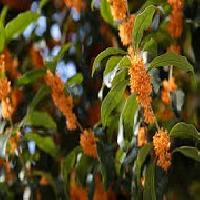
osmanthus
Osmanthus is a genus of about 30 species of flowering plants in the family Oleaceae, mostly native to the warm temperate zone, from the Caucasus east to Japan, with one species (O. americanus) occurring in the southeastern United States, from Texas to Virginia. It is sometimes included in Nestegis.Osmanthus range in size from shrubs to small trees, 2–12 m (7–39 ft) tall. The leaves are opposite, evergreen, and simple, with an entire, serrated or coarsely toothed margin.
...more
orris
Orris root is a term used for the roots Iris germanica, Iris florentina, and Iris pallida.Once important in western herbal medicine, it is now used mainly as a fixative and base note in perfumery, the most widely used fixative for potpourri. Orris is also an ingredient in many brands of gin. After an initial drying period, which can take five years or more depending on the use, the root is ground. For potpourri, this powder is used without further processing. For other uses, it is dissolved in water and then distilled. One ton of iris root produces two kilos of essential oil, also referred to as orris root butter, making it a highly-prized substance.
...more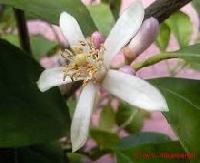
Orange
Orange flower absolute, also referred to as orange blossom absolute, is extracted from the blossoms of the bitter orange tree (Citrus aurantium amara) by means of solvent extraction. It is dark orange in colour and much thicker than neroli oil, which is extracted from orange blossoms by a different method.Citrus aurantium is evergreen small treel, spiny and irregularly branched. Its small, elliptic to oblong leaves are pale green.The white flowers are small and produced in axillary clusters. The fruit is small, roundish and thin-skinned.The pulp is greenish and in sections of about ten. The juice is acid with a distinctive flavor.The fruit is used in much the same way as Lemon.Flowers smell sweet and they have five petals that are white and some kinds have purple staining in the outer surfaces.Orange Flower Absolute, also known as Neroli absolute has an exquisite and exotic scent. It is a wonderful ingredient in perfumery and a great addition to bath and body formulations. Orange Flower Absolute possesses the properties of being an antidepressant, antiseptic, antispasmodic, carminative, digestive, and tonic.
...more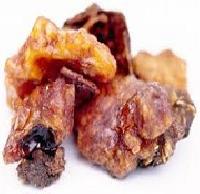
OPOPONAX perfume
Opoponax or sweet myrrh is a cousin of the healing Myrrh—Commiphora Myrrha—with a warm-balsamic and sweet, honey-like aroma. It is a natural oleo-gum-resin like myrrh and frankincense. The color of its resin is brown; however, good quality crude botanical resin is dark red. Opoponax has been a component of incense and perfumes since Biblical times. Talking of perfumery in particular, Opoponax qualities from several Commiphora are widely used, especially in oriental fragrances, to impart sweet balsamic notes..Opopanax (also: Opoponax) refers to a number of gum resins with medicinal properties.In perfumery, opopanax refers to the resin obtained from Commiphora erythraea Engl. var. glabrescens Engl., a tree growing in Somalia. A resinoid is prepared from the resin by solvent extraction. Steam distillation of the resin gives the essential oil, which has a warm, sweet, balsamic odor. Opopanax oil and resinoid are used in perfumes with oriental characteristics.African opopanax is the resin of Commiphora kataf .Opopanax, a major export article from Somalia since ancient times, is also known as bisabol - bissa bol (Hindi) and as hebbakhade - habak hadi (Somali). "bissa bol" (Hindi) is scented myrrh, in contrast to "heera bol", bitter myrrh.
...more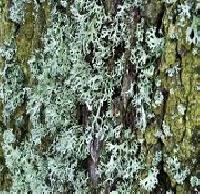
OAKMOSS
Evernia prunastri, also known as Oakmoss, is a species of lichen. It can be found in many mountainous temperate forests throughout the Northern Hemisphere, including parts of France, Portugal, Spain, North America, and much of Central Europe. Oakmoss grows primarily on the trunk and branches of oak trees, but is also commonly found on the bark of other deciduous trees and conifers such as fir and pine. The thalli of Oakmoss are short (3–4 cm in length) and bushy, and grow together on bark to form large clumps. Oakmoss thallus is flat and strap-like. They are also highly branched, resembling the form of deer antlers. The colour of Oakmoss ranges from green to a greenish-white when dry, and dark olive-green to yellow-green when wet. The texture of the thalli are rough when dry and rubbery when wet. It is used extensively in modern perfumery.
...more
Nutmeg
The nutmeg tree is any of several species of trees in genus Myristica. The most important commercial species is Myristica fragrans, an evergreen tree indigenous to the Banda Islands in the Moluccas of Indonesia.The nutmeg tree is any of several species of trees in genus Myristica. The most important commercial species is Myristica fragrans, an evergreen tree indigenous to the Banda Islands in the Moluccas (or Spice Islands) of Indonesia.Nutmeg is the seed of the tree, roughly egg-shaped and about 20 to 30 mm (0.8 to 1.2 in) long and 15 to 18 mm (0.6 to 0.7 in) wide, and weighing between 5 and 10 g (0.2 and 0.4 oz) dried, while mace is the dried "lacy" reddish covering or aril of the seed. The first harvest of nutmeg trees takes place 7–9 years after planting, and the trees reach full production after twenty years. Nutmeg is usually used in powdered form. This is the only tropical fruit that is the source of two different spices. Several other commercial products are also produced from the trees, including essential oils, extracted oleoresins, and nutmeg butter.
...more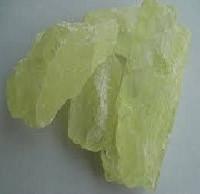
Nitro Musk Subsitute
Natural animal musks have long been used as fragrances in beauty products, but because they are expensive to produce, scientists have developed synthetic chemicals to replace them. These synthetic compounds include nitro and non-nitro benzenes, indans and tetralins. Musk xylene, musk ketone and musk ambrette are three of the most commonly used synthetic nitro musk compounds. They are produced and used throughout the world in such scented products as detergents, soaps, lotions and perfumes. In 1988, an estimated 7,000 tons of musks were produced worldwide.Very little scientific research has been done on synthetic musk fragrances in the environment.
...more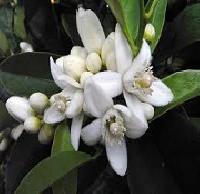
neroli
Neroli is a plant oil produced from the blossom of the bitter orange tree (Citrus aurantium subsp. amara or Bigaradia). Its scent is sweet, honeyed and somewhat metallic, whereas bergamot, being rich in linalool (which is the main component in lavender), has more of an aromatic, soft floralcy.The blossoms are gathered, usually by hand, in late April to early May. The oil is produced by water distillation, as the blossom is too fragile to endure distillation with direct steam.By the end of the 17th century, Anne Marie Orsini, duchess of Bracciano and princess of Nerola, Italy, introduced the essence of bitter orange tree as a fashionable fragrance by using it to perfume her gloves and her bath. Since then, the term "neroli" has been used to describe this essence.
...more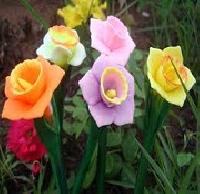
narcissus flower
Narcissus is a botanical name for the sort of springtime bulbous plant of amaryllis family, Amaryllidaceae. There are around 26 of wild and several hundreds of cultivated variances, and although it is mainly considered to be a spring-time flower, some sorts bloom in autumn. Sorts are different by color, shape and size. The flower can be yellow or white, but also combined white and yellow, orange, red, and pink. The flowers, growing on a strong stalk, can be star-shaped or trumpet shaped, simple or multi-flowered. The leaves are long and light-green.
...moreBe first to Rate
Rate This